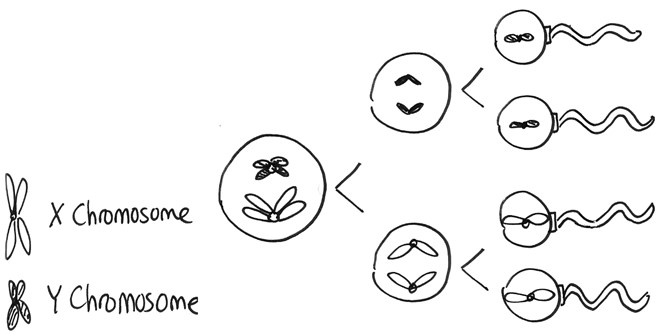10.2 Autosomes and Sex Chromosomes
In diploids, most chromosomes exist in pairs (same length, centromere location, and banding pattern), with one set coming from each parent. These chromosomes are called autosomes. However, many species have an additional pair of chromosomes that do not look alike. These are sex chromosomes because they differ between the sexes. In humans, males have one of each while females have two X chromosomes. Autosomes are those chromosomes present in the same number in males and females, while sex chromosomes are those that are not. When sex chromosomes were first discovered, their function was unknown, and the name X was used to indicate this mystery. The next ones were named Y, then Z, and then W (depending on the species).
The combination of sex chromosomes within a species is associated with either male or female individuals. In mammals, fruit flies, and some dioecious plants, those with two X chromosomes are females, while those with an X and a Y are males. In birds, moths, and butterflies, males are ZZ and females are ZW. Because sex chromosomes have arisen multiple times during evolution the molecular mechanism(s) through which they determine sex differs among those organisms. For example, although humans and Drosophila both have X and Y sex chromosomes, they have different mechanisms for determining sex (see Chapter 11).
How do the sex chromosomes behave during meiosis? Well, in those individuals with two of the same chromosomes (i.e., homogametic sexes: XX females and ZZ males), the chromosomes pair and segregate during meiosis I, the same as autosomes. During meiosis in XY males or ZW females (heterogametic sexes), the sex chromosomes pair with each other.
Take a look at this video, 7R – Sex chromosomes in Meiosis, produced by Professor Redfield of UBC (Useful Genetics, 2015), which discusses what occurs with sex chromosomes during meiosis.
In mammals (XX, XY), the consequence is all egg cells will carry an X chromosome, while the sperm cells will carry either an X or a Y chromosome. Half of the offspring will receive two X chromosomes and become female, while half will receive an X and a Y and become male (Figure 10.3). In species with ZZ males, all sperm carry a Z chromosome, while in females, ZW, half will have a Z and half a W.
It is a popular misconception that the X and Y chromosomes were named based upon their shapes; physically each looks like any other chromosome. A Y-chromosome doesn’t look like a Y any more than a chromosome 4 looks like a 4. The combination of sex chromosomes within a species is associated with either male or female individuals. In mammals, fruit flies, and some flowering plants, XX individuals are females, while XY individuals are males.

Media Attributions
- Figure 10.2.1 Original by M. Harrington (2017), CC BY-NC 3.0, Open Genetics Lectures
References
Harrington, M. (2017). Figure 2. Meiosis in an XY mammal [digital image]. In Locke, J., Harrington, M., Canham, L. and Min Ku Kang (Eds.), Open Genetics Lectures, Fall 2017 (Chapter 20, p. 2). Dataverse/ BCcampus. http://solr.bccampus.ca:8001/bcc/file/7a7b00f9-fb56-4c49-81a9-cfa3ad80e6d8/1/OpenGeneticsLectures_Fall2017.pdf
Redfield, R./ UBC [Useful Genetics]. (2015, August 23). 7R – Sex chromosomes in meiosis (video file). YouTube. https://www.youtube.com/watch?v=kiZWI_yuGDM
Long Description
- Figure 10.2.1 The process of meiosis in a human male demonstrates the stages of anaphase I, anaphase II, and mature sperm cells. Half of the sperm cells produced contain an X chromosome, and half of the sperm cells contain a Y chromosome. This indicates males can only pass on their Y linked traits to their sons, not their daughters. [Back to Figure 10.2.1

